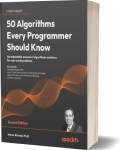50Algorithms Every Programmer Should Know - Second Edition
Algorithm Data Structures
Book Details
Book Title
50Algorithms Every Programmer Should Know - Second Edition
Author
Imran Ahmad
Publisher
Packt Publishing
Publication Date
2023
ISBN
9781803247762
Number of Pages
539
Language
English
Format
File Size
5.4MB
Subject
Computers>Algorithms and Data Structures
Table of Contents
- Cover
- Copyright
- Contributors
- Table of Contents
- Preface
- Section 1: Fundamentals and Core Algorithms
- Chapter 1: Overview of Algorithms
- What is an algorithm?
- Python packages
- Algorithm design techniques
- Performance analysis
- Selecting an algorithm
- Validating an algorithm
- Summary
- Chapter 2: Data Structures Used in Algorithms
- Exploring Python built-in data types
- Exploring abstract data types
- Summary
- Chapter 3: Sorting and Searching Algorithms
- Introducing sorting algorithms
- Introduction to searching algorithms
- Practical applications
- Summary
- Chapter 4: Designing Algorithms
- Introducing the basic concepts of designing an algorithm
- Understanding algorithmic strategies
- A practical application – solving the TSP
- Presenting the PageRank algorithm
- Understanding linear programming
- Summary
- Chapter 5: Graph Algorithms
- Understanding graphs: a brief introduction
- Graph theory and network analysis
- Representations of graphs
- Graph mechanics and types
- Introducing network analysis theory
- Understanding graph traversals
- Case study: fraud detection using SNA
- Summary
- Section 2: Machine Learning Algorithms
- Chapter 6: Unsupervised Machine Learning Algorithms
- Introducing unsupervised learning
- Understanding clustering algorithms
- Steps of hierarchical clustering
- Coding a hierarchical clustering algorithm
- Understanding DBSCAN
- Creating clusters using DBSCAN in Python
- Evaluating the clusters
- Dimensionality reduction
- Association rules mining
- Summary
- Chapter 7: Traditional Supervised Learning Algorithms
- Understanding supervised machine learning
- Formulating supervised machine learning problems
- Understanding classification algorithms
- Decision tree classification algorithm
- Understanding the ensemble methods
- Logistic regression
- The SVM algorithm
- Bayes’ theorem
- For classification algorithms, the winner is...
- Linear regression
- For regression algorithms, the winner is...
- Practical example – how to predict the weather
- Summary
- Chapter 8: Neural Network Algorithms
- The evolution of neural networks
- Understanding neural networks
- Training a neural network
- Understanding the anatomy of a neural network
- Defining gradient descent
- Activation functions
- Tools and frameworks
- Choosing a sequential or functional model
- Understanding the types of neural networks
- Using transfer learning
- Case study – using deep learning for fraud detection
- Summary
- Chapter 9: Algorithms for Natural Language Processing
- Introducing NLP
- Understanding NLP terminology
- Cleaning data using Python
- Understanding the Term Document Matrix
- Introduction to word embedding
- Implementing word embedding with Word2Vec
- Case study: Restaurant review sentiment analysis
- Applications of NLP
- Summary
- Chapter 10: Understanding Sequential Models
- Understanding sequential data
- Data representation for sequential models
- Introducing RNNs
- GRU
- Introducing LSTM
- Summary
- Chapter 11: Advanced Sequential Modeling Algorithms
- The evolution of advanced sequential modeling techniques
- Exploring autoencoders
- Understanding the Seq2Seq model
- Understanding the attention mechanism
- Delving into self-attention
- Transformers: the evolution in neural networks after self-attention
- LLMs
- Summary
- Section 3: Advanced Topics
- Chapter 12: Recommendation Engines
- Introducing recommendation systems
- Types of recommendation engines
- Understanding the limitations of recommendation systems
- Areas of practical applications
- Practical example – creating a recommendation engine
- Summary
- Chapter 13: Algorithmic Strategies for Data Handling
- Introduction to data algorithms
- Presenting the CAP theorem
- Decoding data compression algorithms
- Practical example: Data management in AWS: A focus on CAP theorem and compression algorithms
- Summary
- Chapter 14: Cryptography
- Introduction to cryptography
- Understanding the types of cryptographic techniques
- Example: security concerns when deploying a machine learning model
- Summary
- Chapter 15: Large-Scale Algorithms
- Introduction to large-scale algorithms
- Characterizing performant infrastructure for large-scale algorithms
- Strategizing multi-resource processing
- Understanding theoretical limitations of parallel computing
- How Apache Spark empowers large-scale algorithm processing
- Using large-scale algorithms in cloud computing
- Summary
- Chapter 16: Practical Considerations
- Challenges facing algorithmic solutions
- Failure of Tay, the Twitter AI bot
- The explainability of an algorithm
- Understanding ethics and algorithms
- Reducing bias in models
- When to use algorithms
- Summary
- Packt page
- Other Books You May Enjoy
- Index
